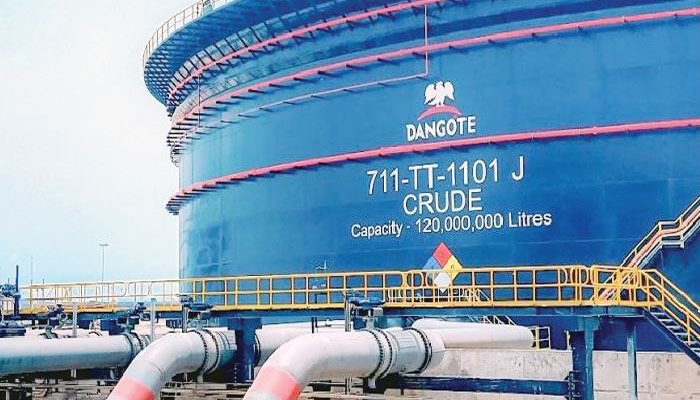There is anticipated competition staring on local refiners in Nigeria as India prepares to launch a massive importation scheme targeting Nigerian crude to satisfy her refining needs.
Analysts are watching how this development would impact Nigerian government’s policy to balloon in-country refining capacity aimed at reducing dependence on imported petroleum products.
Currently, Nigeria is actively developing its local refining capacity through the Naira-for-Crude policy, a long-term national policy directive designed to boost domestic refining and ensure energy security.
This policy mandates that the Nigerian National Petroleum Company Limited (NNPC) sells crude oil to local refineries in Naira, not dollars, and also requires refineries to pay regulatory costs and sell some products (like diesel) in Naira.
The goal is to stabilise the currency, reduce reliance on imports, and transform Nigeria into an energy self-sufficient nation.
The policy’s implementation involves a coordinated effort from regulatory bodies, and the recent full rollout reaffirms the government’s commitment to achieving these objectives.
But the hard reality of Donald Trump’s sanction against Russia would create a stiff competition between India and local refiners in Nigeria.
The US sanction against Russia is seen as the beginning of a long-term relationship between India and Nigeria.
India, has been enjoying the low sulfur content of Nigerian crude grades, making them ideal for India’s refineries.
However, India will now have to contend with Africa’s largest refinery–the Dangote Refinery.
According to Devakumar Edwin, vice president Dangote Industries, the giant refinery will buy 100 per cent of its crude from the Nigerian market by the end of the current year, a reversal from its earlier trend of buying most of its crude from the United States, Brazil, Equatorial Guinea, Angola and Ghana.
The 650,000-barrel-per-day refinery began operations in 2024 after repeated delays.
Ranked as having a higher capacity than Europe’s largest refineries, the $20-billion refinery now produces diesel, gasoline, aviation fuel and naphtha. Though yet to ramp up operations to full capacity, the Dangote refinery has been a major milestone for Nigeria and Africa’s energy sector, transforming Africa’s largest oil producer into a net exporter of petroleum products.
However, the refinery was initially forced to rely on large volumes of imported crude, with local traders unable to meet its demand.
Through improved coordination the government and local oil traders have made the supply of domestic crude more consistent and reliable. Last month, Dangote refinery purchased 53 per cent of its crude from Nigerian producers, with 47 per cent coming from the United States.
According to Edwin, the plant is currently processing 550,000 barrels of crude per day, good for 84.6 per cent of its maximum capacity.
The US Sledge Hammer On Russia
Just recently the U.S. President Donald Trump came down hard on India, doubling its tariff rate from 25 per cent to 50 per cent for fueling Putin’s war in Ukraine by continuing to buy massive quantities of Russian oil.
India’s imports of Russian commodities skyrocketed since the war began, surging to $65.7 billion in 2024 from $8.25 billion in 2021, according to India’s The Business Standard.
In sharp contrast, imports by the European Union and the U.S. have declined by more than 80 per cent as they look to choke Russia’s war machine. And now India has rapidly moved to distance itself from Moscow, turning to Africa and other suppliers as it goes into a buying frenzy.
In recent weeks, Indian refiners have purchased two million barrels of Nigerian crude for September and October delivery; one million barrels of Angola’s Girassol, three million barrels of Abu Dhabi Murban, and a million barrels of U.S. Mars.
Interestingly, India is returning to the spot market, with the state refiner Bharat Petroleum Corporation Limited (BPCL) making spot purchases and also negotiating for September deliveries.
Over the past couple of years, India has become the biggest buyer of discounted Russian crude, accounting for 40 per cent of its total imports at its peak in 2024. This was enough to meet India’s surging oil demand and keep it off the spot markets.
“In the interest of developing bilateral cooperation with countries having rich mineral resources, the Ministry of Mines has entered into bilateral agreements with the governments of several countries, including Australia, Argentina, Zambia, Peru, Zimbabwe, Mozambique, Malawi, and Côte D’Ivoire, as well as international organizations such as the International Energy Agency (IEA),” India’s Minister of State for Atomic Energy, Jitendra Singh, said in a written statement.
Still, India has adopted a recalcitrant tone, vowing to continue buying Russia’s crude, two sources previously told Reuters.”These are long-term oil contracts. It is not so simple to just stop buying overnight,’’ one of the sources said.
A second source tried to justify India’s imports of Russian crude, claiming it had helped to avert a surge in global oil prices.
The source also pointed out that, unlike the situation in other heavily sanctioned countries like Iran and Venezuela, Russian crude is currently not subject to direct sanctions, and India was only buying from the embattled country because it offered cheaper oil thus shaving billions of dollars off its energy bill every year.
Well, this might actually be India’s official position: According to India’s foreign ministry, India has maintained a “steady and time-tested partnership” with Russia. “On our energy sourcing requirements … we look at what is available in the markets, what is there on offer, and also what is the prevailing global situation or circumstances,” he said
As the sanction sustains crude oil refiners in India are turning to Nigeria’s crude oil to satisfy their domestic market demand and this is calculated to position Nigeria for a higher export target between September and October this year.
The Country’s would rise in those months due to increased imports of non-Russian crude by Indian refiners, according to Reuters.
In response to US pressure, Indian Oil Corp and Bharat Petroleum purchased 22 million barrels of non-Russian crude, including U.S. Mars, Brazilian, and Libyan grades.
These spot purchases represent about 6 per cent of India’s May crude processing and are supported by favorable arbitrage economics for Asian refiners.
Following pressure from the United States to stop buying from Russia, India’s largest state refiners, Indian Oil Corp and Bharat Petroleum, purchased at least 22 million barrels of non-Russian crude for delivery in September and October.
After Russia’s invasion of Ukraine, Indian state refiners became one of the few buyers of cheaper Russian crude, largely removing themselves from the spot market since 2022.
In response to pressure from US President Donald Trump, they halted Russian acquisitions in late July.
The sources claimed that IOC purchased two million barrels of U.S. Mars crude, two million barrels of Brazilian grades, and an additional one million barrels of Libyan oil on a delivered basis in its most recent tender.
They stated that BP sold the high-sulfur Mars crude shipment for $1.5 to $2 per barrel more than the September Dubai rates.
According to those who spoke to Reuters, the European trader Petraco sold one million barrels of Libyan Sarir and Mesla crude, while Totsa, the trading arm of the company, sold two million barrels of Brazilian Sepia and Sururu crude.
Prices for these cargoes were not immediately available.
Swiss gold refining sector hits US tariff mine and these agreements follow IOC’s purchase of 8 million barrels of crude from the Middle East, the United States, Canada, and Nigeria through tenders last week for September delivery.
Nine million barrels of oil were negotiated for September arrival by BPCL, India’s second-largest state refiner, according to a source familiar with the transactions who spoke to Reuters.
The purchases included two million barrels of Nigerian oil, three million barrels of Abu Dhabi Murban, one million barrels of Angola Girassol, and one million barrels of U.S. Mars, the source said.
Businesses often use confidentiality as an excuse to avoid discussing questionable transactions.
The combined September and October spot purchases by the two state refiners amount to about 6 per cent of India’s May crude processing, according to calculations by Reuters.
These purchases are supported by improving arbitrage economics for Asian refiners when transporting grades from the Atlantic Basin to Asia, Reuters reported.
Global Trade Flow Shockwave Trails India-Nigeria Crude Relationship
The expected surge in India’s crude import from Nigeria according to analysts might fuel global trade flow shockwaves.
This is because the US secondary sanctions are forcing a rapid reassessment of crude buying patterns in Asia, and the implications could reshape pricing, freight and supply balances worldwide. With India holding the key to two-thirds of Russian seaborne exports, the stakes could not be higher.
For decades, the oil market has worked on an unwritten rule: no matter how complex the geopolitics, barrels will find a home. Price solves most problems. Cut it far enough and someone, somewhere, will take the cargo. That belief is now under pressure.
India, which takes roughly 2 million barrels a day (b/d) of Russian seaborne crude and has been one of a handful of major buyers since the start of the Ukraine war, is beginning to pull back.
That flow represents about two-thirds of Russia’s seaborne exports, a cornerstone of Moscow’s post-Ukraine energy lifeline. If it falters, the effects will not stay in one region; they will ripple across shipping routes, price spreads, and supply balances from the Middle East to Europe, reports said.
The shift has not come through a formal prohibition. It is being driven by the shadow of US de facto sanctions and the fear of getting caught on the wrong side of them. Washington’s latest measures include a 21-day window before an extra 25 per cent tariff on India-US trade kicks in.
Technically, that grace period means business can continue, but sentiment has changed. Indian refiners have been buying more legitimate spot cargoes in recent days. Whether this marks a short-term hedging move or the start of a deeper reset is still unclear.
According to reports, if Indian demand shrinks, there is only one buyer with the scale and the geopolitical leverage to take significant extra volumes: China. That is where the easy part ends as China’s trade negotiations with the US complicate the picture, making every incremental Russian barrel a potential diplomatic bargaining chip.
Refiners in China could find space for some of the oil by easing back on other purchases.
There is evidence they are already doing so. Saudi Arabia will reduce its term supplies to Chinese buyers for September, which could be a signal that Beijing is ready to take more discounted Russian cargoes.
The calculation is whether the economic reward outweighs the political risk. Additional Russian flows would come cheap but could disrupt broader trade talks. Elsewhere, the options are thin. Some smaller refiners in Southeast Asia or the Middle East might be able to handle the grades, but the same sanction pressure may end up being directed at them, and few governments will be willing to take that risk.
Even core OPEC producers such as Saudi Arabia and the UAE are unlikely to process and re-export Russian crude in the way Indian refiners have.
That leaves a narrowing funnel for Russian exports. A smaller pool of buyers increases their leverage on price, a short-term win for China but a long-term vulnerability for Moscow. Dependence on a single customer brings its own set of risks, especially when that customer’s priorities may change overnight.
If as much as half a million barrels a day are displaced from India’s intake, the Middle Eastern spot market will tighten quickly.
Sour crude grades linked to Dubai pricing would be bid up, narrowing the Brent-Dubai spread. Refiners looking to replace Russian barrels would compete for similar types of oil, intensifying pressure on prices.
The freight market would feel it almost immediately. More tonne-miles for legitimate cargoes would push rates higher, while dark fleet tankers carrying Russian supply would have to travel further to reach their limited destinations. That increases voyage times and costs, straining an already fragmented logistics chain.
Should China delay in taking the surplus, the warning signs will show up offshore. Cargoes will sail without a declared destination, or float on the water, turning into floating storage by default.
In the early months after the Ukraine invasion, Russian crude spent weeks at sea in search of buyers. If history repeats, Russian export terminals could soon become congested, leading to short-term production shut-ins.
Those interruptions are costly, not just in lost revenue, but in the technical difficulties of restarting wells.
The regional picture would be far from uniform. Turkey, currently taking around 300,000b/d of Russian crude, could step up legitimate spot crude purchases, tightening the Mediterranean market. Products would be caught in the crossfire. Russia is a key exporter of fuel oil to India and diesel to Turkey; disruption to either could squeeze European supply and push the east-west diesel spread wider.
The idea of a unified global crude market is already fading. Sanctioned Russian oil trades in its ecosystem, with a limited and well-known set of buyers. A sharp cut in Indian demand would further shrink that group, concentrating power in the hands of Chinese refiners, analysts opined.
A concentrated customer base could also reshape freight flows. If almost all sanctioned crude is heading to a single geography, shipping patterns become more predictable. That could lower costs for the buyer, but it makes the system more fragile if any chokepoint or political dispute interrupts the route. For Russia, it amplifies the risk that a single change in Chinese policy could leave cargoes stranded.
The long-term consequences for Russia’s upstream sector are equally stark. Without enough end-markets, production must eventually fall. After sanctions were first imposed in 2022, many forecast steep drops in Russian output. Those declines never came, mainly because India absorbed the volumes. Remove that outlet, and the calculus changes. Wells might be shut in, investment deferred, and capacity lost over time.
Right now, the clearest indicator is Indian buying activity.
Analysts are counting every barrel— whether it comes from the US Gulf, the Caspian, or the Middle East—to see how the mix is shifting. If purchases from Russia continue to decline, the market will likely view it as the beginning of a trend rather than a temporary pause.
Two other signs will matter: One is how Chinese term allocations from major suppliers, particularly Saudi Arabia, adjust in the coming months. A significant cut would indicate room for more Russian oil. The other is the reappearance of undelivered Russian cargoes loitering at sea, a visible red flag that buyers are in short supply.
If the pullback does stick, the consequences will be felt well beyond Moscow’s balance sheet. The global oil system depends on the frictionless redirection of flows. Remove a buyer of India’s scale, and that friction rises sharply. Freight rates jump. Regional price spreads swing wider. Refining margins shift, favouring some markets while hurting others and oil flat price would rise.
In a world already unsettled by geopolitical shocks, such a disruption could speed the emergence of distinct, politically aligned trading blocs. In one, sanctioned barrels move at steep discounts within a closed loop of willing buyers. In the other, unsanctioned crude circulates through the mainstream market at prices determined more by fundamentals than foreign policy.
This moment is not just another twist in the Russia-India trade story. It could be a turning point in the way global oil moves, is priced, and is controlled. If India walks away for good, the impact will reach far beyond the ports and pipelines of the two countries.
It will touch every refinery, every shipping lane, and every trader with a stake in the world’s most vital commodity, say analysts.





